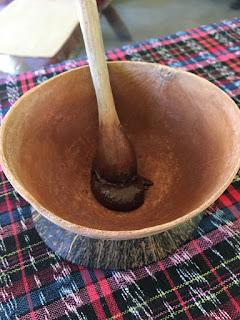The primary reason that we went to San Ignacio was to visit Mayan ruins in the area, but we wanted to see San Ignacio on its own merits also. While exploring the city, we passed by a chocolate factory offering tours of the manufacturing process.
Julia and I had low expectations, but we were very pleasantly surprised and would recommend the Ajaw Chocolate factory tour to anyone with even a modest interest in chocolate and how it’s made. The fruit was nothing like I would have imagined. The beans are separated from the fruit, fermented and then roasted. At each stage, we were invited to touch, smell, and taste.
In many countries, automated machinery is used to harvest and process. That’s not the case at Ajaw. We were shown the stone grinding process to create an intense chocolate paste.We were also offered the opportunity to try grinding the roasted beans ourselves. Julia did pretty well. I made a bit of a mess and got chocolate all over the grinding stone. The guide is explaining to the others not to do that.
Chocolate and coffee share one other thing in common. Our guide complained that some of the world’s best known chocolate is advertised as Swiss chocolate or Belgium chocolate. Just about everyone has heard of French roast or Italian roast coffee. While both cocoa and coffee beans may be processed anywhere in the world, neither are grown in Europe. Our guide was very proud of locally grown Belize chocolate. When people have that kind of passion about creating a product, the quality almost always shines through. The chocolate was amazing.
















No comments:
Post a Comment